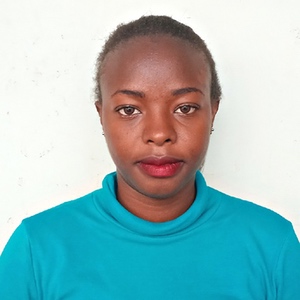The 110 community members who live in Eshisa struggle to collect sufficient water to meet their daily needs from their primary water source, Opati Spring.
The spring is currently experiencing multiple problems, and the water it yields is contaminated, leading to various health issues among the community members.

"The spring is partially protected and open to contamination from the farming activities taking place close to the spring. The community members are prone to water-related illnesses making them less productive. The spring serves a huge population, [and] they queue for a long time to fetch water, and this leads to frustration and disunity in the community," shared Field Officer Faith Muthama.
Eight-year-old Wycliffe knows the struggle well. Like many young girls in Kenya, she is tasked with collecting water each day to help meet her family's water needs. It is an exhausting and disheartening task.
"I feel frustrated before l even reach the waterpoint because [of] the discouragement l am going to find there is diminishing," Wycliffe said.
"A lot of times, l have been told all sorts of words by my elders [in] the spring, which makes me discouraged. Mostly l am told to go at the back of the line and let my elders fetch water first. This makes me take water late [to my] home, and this makes my parents furious with me because l do not bring water on time at home. The queue can be so long, and l have no other option than to wait."
"It makes me get to school late in the morning. In the evening, l get minimal time to read on my own and also less time to do my homework that l have been given in school," she continued.
Wycliffe not only faces discouragement and pressure, but regrettably, she also suffers the consequences of drinking unsafe water often, which leads to further distress and keeps her out of school even longer.
"I often become sick with water-related illnesses, and that deteriorates my health. When l got sick, l felt weak and could not go to school for some days, and it took me [so] long to get back [on] my feet," shared Wycliffe.
"My parents took me to [the] hospital to seek medication, and also they paid for my medicines that l was prescribed by the nurse in charge. l could not go to school due to the condition l was in; it could not allow me to attend school. I was weak, and also the vomiting and diarrhea made me restless," she continued.
We asked Wycliffe to share her plans if she had access to clean water in the future. She said, "My plans for the future are to get higher grades so that I can make my parents proud by going to a good national school here in Kenya."

Field Officer Faith is hopeful that clean water can really change this community. "By protecting water for them, it will solve a lot of issues that arise there, such as time-consuming due to queueing for a long time, and also the issue of water-related illnesses will be controlled."
Steps Toward a Solution
Our technical experts worked with the local community to identify the most effective solution to their water crisis. They decided to safeguard the existing flowing spring.
Spring Protection
Springs are natural water sources that originate from deep underground. As water travels through various layers of the earth, it undergoes a natural filtration process, making it cleaner and safer to drink. To protect these spring sources from contamination, we construct a waterproof cement structure around layers of clay, stone, and soil. This design channels the spring water through a discharge pipe, facilitating easier, faster, and cleaner water collection.
Chlorine Dispenser
As an extra measure towards water quality safety, uniquely engineered chlorine dispensers are installed at all of our spring protection projects so community members can treat their water with pre-measured doses of chlorine. The chlorine treats any residual contamination and stays active for two to three days, ensuring water stays safe to use even when stored at home. Chlorine delivery and maintenance of the dispensers are part of our ongoing community support.
Community Education & Ownership
Hygiene and sanitation training are integral to our water projects. Training is tailored to each community's specific needs and includes key topics such as proper water handling, improved hygiene practices, disease transmission prevention, and care of the new water point. Safe water and improved hygiene habits foster a healthier future for everyone in the community. Encouraged and supported by the guidance of our team, a water user committee representative of the community's diverse members assumes responsibility for maintaining the water point, often gathering fees to ensure its upkeep.

 Protected Spring
Protected Spring
 Rehabilitation Project
Rehabilitation Project




































